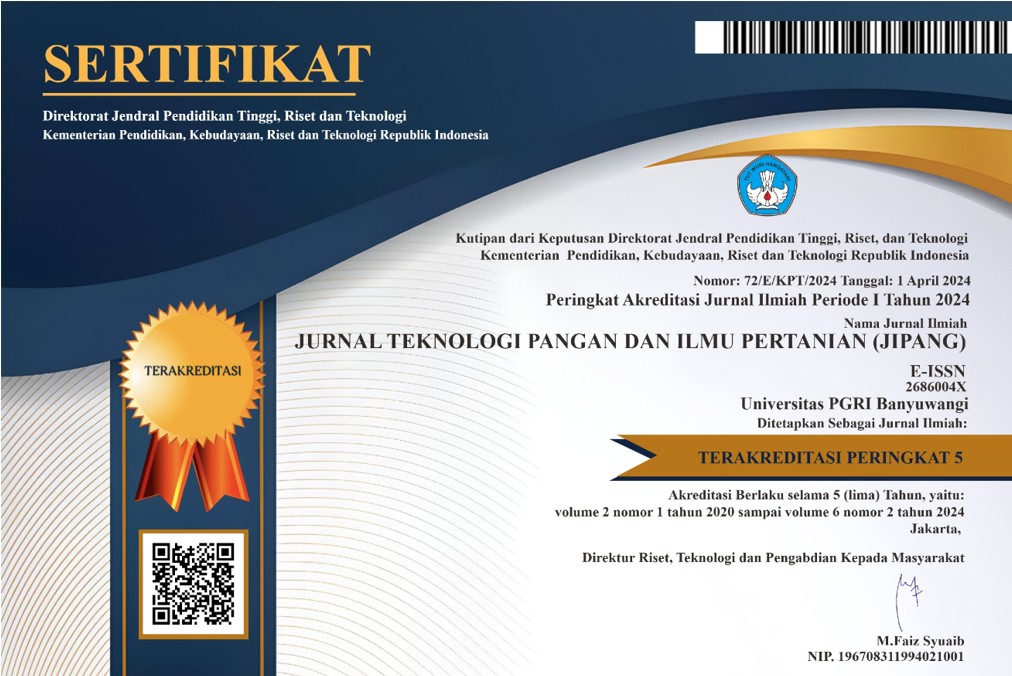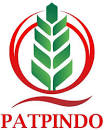PEMBUATAN KERUPUK DENGAN PENAMBAHAN PUREE IKAN TONGKOL (Euthynnus affinis) DENGAN METODE PENGERINGAN CABINET DRIYING
Manufacturing Crackers With The Addition of Trunk Fish (Euthynnus affinis) Puree Using The Cabinet Drying Method
Keywords:
Crackers, Moisture content, Organoleptic, Puree, SnackAbstract
Crackers are a food that is widely consumed by the public, known as a food with a crunchy texture and usually used as a complementary food. Crackers can also be made with the addition of fish, produced from a mixture of fish meat or puree and the remaining water from cooking the fish. The fish used to add cracker dough is usually fish that has a strong aroma and taste, such as tuna. Tuna (Euthynnus affinis) is one type of fish that is widely processed into food products, but its application in processing crackers is still very limited. Therefore, this research was conducted to determine the effect of adding tuna puree on the moisture content and also the organoleptic quality (taste, texture, color and aroma) of the crackers produced. The research was carried out using a completely randomized design with one factor, namely variations in the concentration of tuna puree, including tuna puree 0% (P0), 20% (P1), 30% (P2), 40% (P3), and 50% (P4). . The research data was subjected to statistical analysis using ANOVA (Analysis of Variance) and further testing was carried out using DMRT (Duncan Multiple Range Test) if there were significant differences between test treatments. The research results showed that the addition of tuna puree had a real influence on the organoleptic quality, including the parameters of the crackers produced. The addition of 40% tuna puree was considered to have the best taste, color and aroma, while the addition of 50% puree (P4) was considered to have the best texture, while the addition of tuna puree was able to increase the water content. the resulting crackers.
References
Amertaningtyas, D. (2011). Mini Review : Pengolahan kerupuk rambak kulit di indonesia. Jurnal Ilmu-Ilmu Peternakan 21(3): 18–29.
Badan Pusat Statistik Situbondo. 2017. Produksi dan Nilai Perikanan Tangkap menurut Jenis Ikan di Kabupaten Situbondo.
Diniarti, N., N. Cokrowati., D. N. Setyowati., & A. Mukhlis. Edukasi gizi ikan melalui pelatihan pembuatan makanan olahan berbahan baku ikan tongkol. Jurnal Abdi Insani Universitas Mataram. 7(1): 49-54.
Mawaddah, N., Mukhlishah, N., Rosmiati, & Mahi, F. (2021). Uji daya kembang dan uji organoleptik kerupuk ikan cakalang dengan pati yang berbeda. Jurnal Pertanian Berkelanjutan. 9(3): 181.
Nursholeh, M., Azis, L., Hariyandi, H., & Dzulfikri, M. A. (2022). Efek rasio penambahan tepung singkong dan ikan tongkol (Euthynnus affinis) terhadap sifat organoleptik dan daya kembang kerupuk. Jurnal Teknologi Dan Mutu Pangan. 1(1), 5–9. https://doi.org/10.30812/jtmp.v1i1.2174
Sanger, G. (2010). Oksidasi lemak ikan tongkol (Auxis thazard) asap yang direndam dalam larutan ekstrak daun sirih. Jurnal Pacific. 2(5), 870–873.
Sari, Weni Kurnia, N Ira Sari., & T. Leksono. (2021). Pengaruh penambahan tepung rumput laut (Eucheuma Sp.) Terhadap mutu dan karakteristik amplang ikan tongkol (Euthynnus affinis). Jurnal Teknologi dan Industri Pertanian Indonesia. 13(1): 9–15.
SNI 01-2713-1999. Syarat Mutu Kerupuk Ikan.
SNI-01-2354.2-2006. Cara Uji Kimia-Bagian 2 : Penentuan Kadar Air Pada Produk Perikanan
Supriatna, Dadang., A. Basrah Enie., B.D.S. Moelyana., O. S. (1995). Pengaruh perbandingan daging ikan dengan tapioka dan cara pengeringan terhadap mutu kerupuk ikan tongkol (Euthynnus affinis) yang dibuat secara teknologi intermediet. Warta IHP, 12, 1–2.
Winata, A., Yuliati, K., & Siti, H. (2015). Analisis korelasi harga dan mutu kimiawi kerupuk di pasar tradisional Cinde Palembang. Jurnal Teknologi Hasil Perikanan. 4(2): 179–183.
Zulfahmi, A., F. Swastawati., & R. Romadhon. (2014). Pemanfaatan daging ikan tenggiri (Scomberomorus commerson) dengan konsentrasi yang berbeda pada pembuatan kerupuk ikan. Jurnal Pengolahan dan Bioteknologi Hasil Perikanan 3 (4): 133–39.











